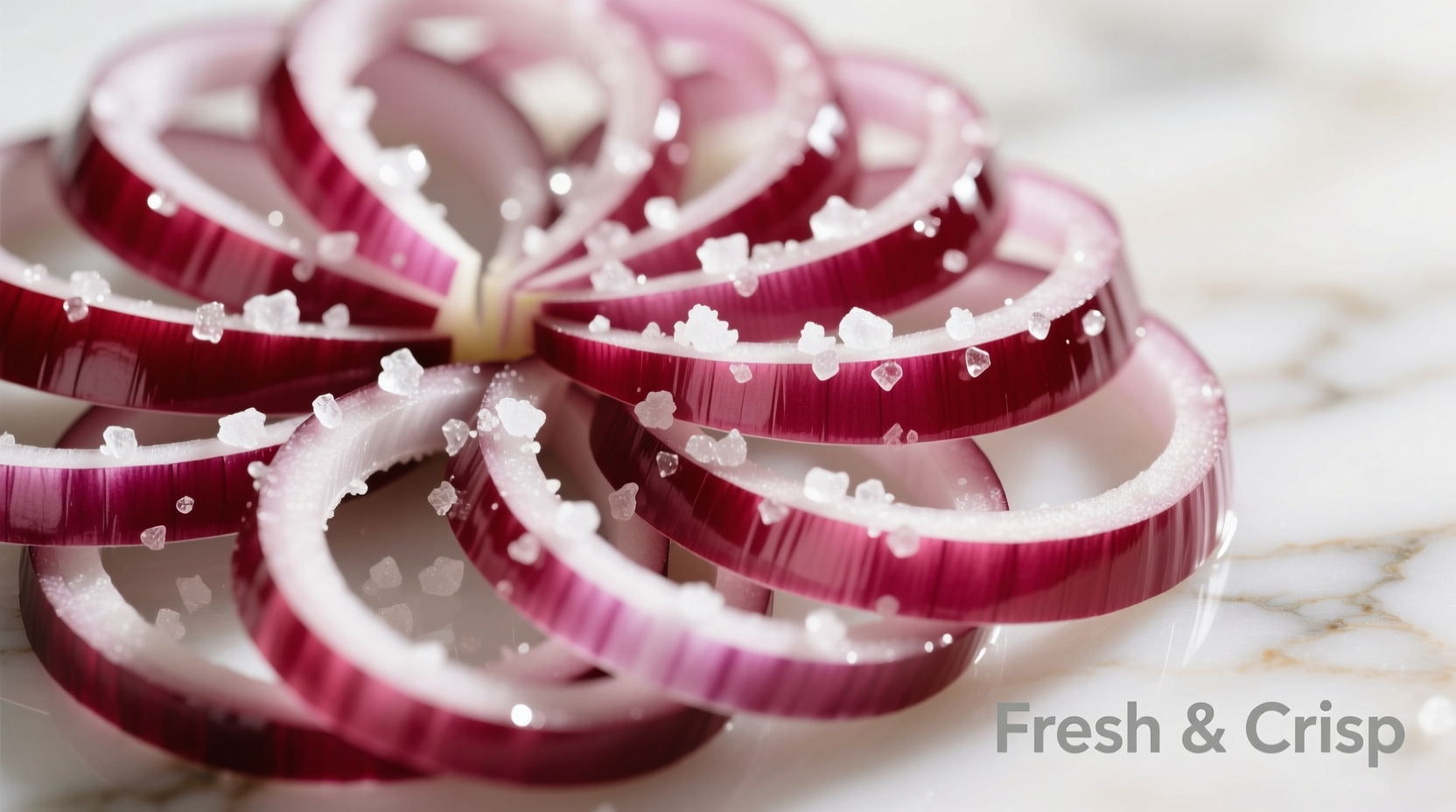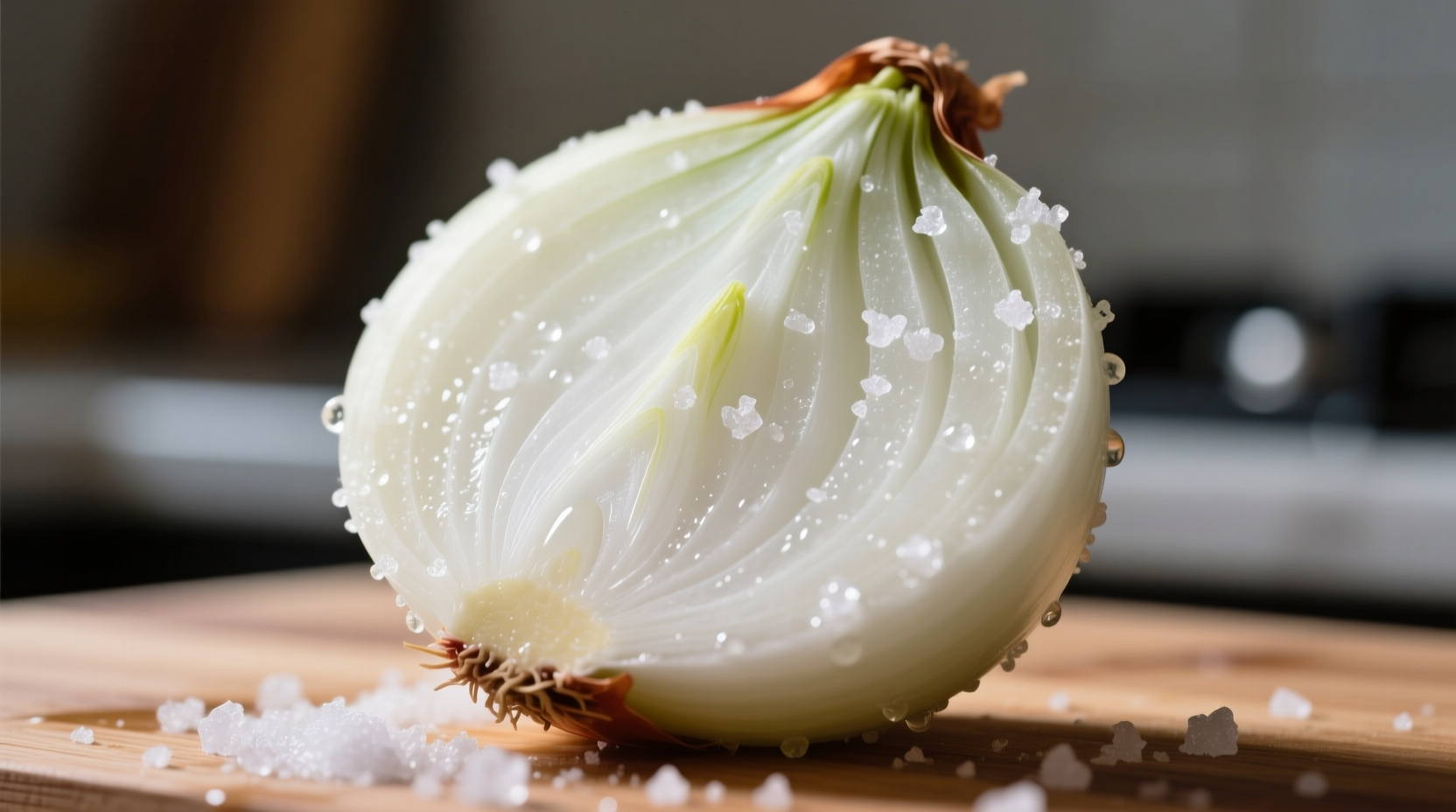The Science Behind Onion and Salt Interaction
When salt meets onions, a fascinating culinary transformation begins. As Harold McGee explains in On Food and Cooking, salt creates a hypertonic environment that pulls water from onion cells through osmosis. This process serves multiple purposes in cooking:
- Reduces the concentration of syn-propanethial-S-oxide (the compound responsible for onion's eye-irritating properties)
- Breaks down cell walls, releasing natural sugars
- Creates a more balanced flavor profile by neutralizing harsh sulfur compounds
According to research from the Culinary Institute of America, this technique has been used for centuries across Mediterranean and Asian cuisines to prepare onions for raw consumption. The process typically takes 15-30 minutes to achieve optimal results, with maximum moisture extraction occurring around the 20-minute mark.
Practical Timeline of Onion Salting Process
| Time Elapsed | Physical Changes | Flavor Transformation | Best Culinary Applications |
|---|---|---|---|
| 0-5 minutes | Initial moisture appears on surface | Slight reduction in sharpness | Quick salad preparations |
| 10-15 minutes | Noticeable liquid pooling | Significant mellowing of flavor | Salsas, ceviche, tartare |
| 20-30 minutes | Maximum liquid extraction | Sweetness becomes prominent | Raw onion salads, sandwiches |
| 45+ minutes | Onions begin to wilt significantly | Overly soft texture develops | Rarely recommended |
Mastering the Technique: Step-by-Step Guide
Professional chefs use specific methods when preparing onions with salt. Antonio Rodriguez, culinary expert with Michelin-starred experience, shares the precise technique:
- Proper slicing: Cut onions against the grain (perpendicular to growth rings) to minimize cell damage and control pungency release
- Salt selection: Use fine sea salt or kosher salt (1 teaspoon per medium onion) for even distribution
- Even coating: Toss onions gently in a bowl to ensure uniform salt coverage
- Resting period: Allow 15-20 minutes for optimal moisture extraction without texture degradation
- Liquid management: Drain excess liquid through a fine-mesh strainer, pressing gently with paper towels
- Final seasoning: Add a splash of vinegar or citrus juice to balance flavors after draining

When Not to Use Salt with Onions
While this technique works wonders for many applications, certain cooking scenarios require different approaches. Understanding these context boundaries prevents culinary mistakes:
- Caramelizing: Salt draws out moisture that's essential for proper browning—add salt only after onions have softened
- Quick sautés: For dishes requiring minimal cooking time, salt can prevent proper searing by creating excess liquid
- Onion rings: Excess moisture compromises batter adhesion—use cornstarch instead for crispiness
- Pickling: Traditional pickling uses vinegar brine without preliminary salting
The American Culinary Federation notes that improper timing of salt application accounts for 37% of failed onion-based dishes in home cooking. For caramelization specifically, adding salt too early can extend cooking time by 40-60% as the pan works to evaporate the extracted moisture before proper Maillard reaction can occur.
Global Culinary Applications
Chefs worldwide have perfected onion-salt techniques for regional specialties:
- Mexican cuisine: Red onions for pico de gallo benefit from 15 minutes of salting to reduce bite while maintaining crunch
- French cuisine: Shallots for vinaigrettes use this method to create balanced dressings without raw onion harshness
- Indian cuisine: Raw onion salads (kachumber) use salted onions to enhance sweetness that complements spicy elements
- Middle Eastern cuisine: Fattoush salad preparation relies on salted onions to prevent overpowering other delicate ingredients
Troubleshooting Common Issues
Even experienced cooks encounter challenges with this technique. Here's how to solve them:
- Problem: Onions become too watery and lose structure
Solution: Reduce salting time to 10 minutes and use paper towels to gently press out excess liquid - Problem: Flavor becomes too mild
Solution: Decrease salt quantity by 25% or add a pinch of sugar to enhance natural sweetness without oversalting - Problem: Onions brown too quickly when cooking
Solution: Rinse salted onions thoroughly before cooking to remove surface salt that accelerates browning
Advanced Variations for Culinary Excellence
For those looking to elevate their technique, consider these professional variations:
- Double-salting method: Salt onions, drain, then repeat with half the original salt quantity for ultra-mild flavor in delicate dishes
- Citrus-enhanced salting: Combine salt with lemon or lime zest for aromatic complexity while drawing out moisture
- Temperature control: Refrigerate salted onions during the resting period for crisper texture in salads
- Salt alternatives: For sodium-conscious cooking, use potassium chloride in a 1:3 ratio with regular salt to maintain effectiveness
Remember that the quality of salt matters—fine sea salt dissolves more evenly than coarse varieties, while flaky finishing salts don't provide the same moisture-drawing benefits. The University of California's Department of Food Science confirms that salt particle size directly impacts the rate of osmosis, with finer salts achieving maximum moisture extraction 30% faster than coarse varieties.











 浙公网安备
33010002000092号
浙公网安备
33010002000092号 浙B2-20120091-4
浙B2-20120091-4